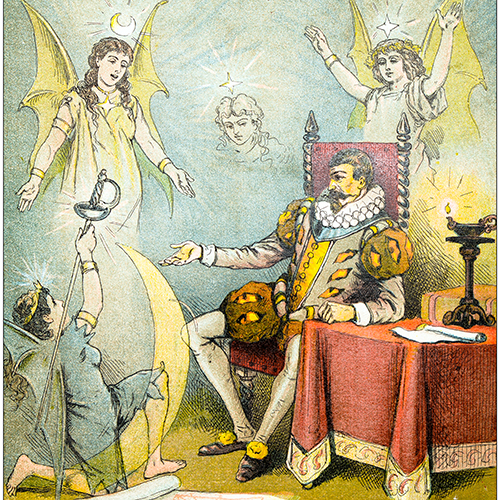
Illustration from The Merry Ballads of the Olden Time, c. 1880
Over the past half century, dwarves, hobbits, elves, magic, dragons, runes, and other staples of fantastic realms have become firmly entrenched in popular culture and mainstream media, from The Lord of the Rings to the Harry Potter series. Are such strange phenomena merely the products of fertile imaginations, or are there substantive historical inspirations behind them? Historian Justin M. Jacobs discusses the evolving conceptions of fantastic elements in Eurasian history and lays bare the truth behind what he sees as four distorted myths of fantasy in popular culture surrounding magic; elves, dwarves, and hobbits; Norse runes; and medieval bestiaries.
Jacobs, a professor of Chinese history at American University, is the author of several books, including Plunder? How Museums Got Their Treasures.
October 9 A History of Magic
Though the concept of magic can be hard to define precisely, an ardent belief that supernatural forces can be conjured via unorthodox rituals, concoctions, and negotiations with luminous forces in unseen worlds has been persistent throughout human history. Jacobs provides an overview of magical practices in ancient and medieval Europe and China. He examines the use and abuse of grimoires (books of magic) in Europe; Daoist medicinal magic in China; the use of charms, amulets, and other folk healing practices in Anglo-Saxon England; and esoteric sexual practices that were believed to cultivate unusual longevity in ancient China.
October 16 Elves, Dwarves, and Hobbits
Ever since the publication of The Hobbit in 1937, furry little people who reside in unseen corners of the world have become a mainstay of the fantasy genre in both literature and film. But there is a much longer history behind popular images of “little people” that predates Tolkien’s hobbits by nearly 2,000 years. Jacobs explores ever-evolving conceptions of elves, dwarves, hobbits, and other diminutive folk, from Scandinavian mythology and medieval European depictions to Victorian racial interpretations and Tolkien’s radical recasting of little people in his world of Middle-Earth.
October 23 Old Norse Runes
Runic scripts appear in depictions of fantasy worlds with such predictability that they can almost be considered a cliché of the genre. Jacobs delves into the Old Norse runic script that started it all, from its murky origins in the early first millennium and ubiquitous appearance on Viking memorial stones to underground graffiti left by Scandinavian Crusaders en route to Jerusalem and bawdy drivel carved on flimsy wooden sticks in long-forgotten alehouses. He explains why Old Norse runes were carved rather than written, the surprising similarities to the Roman alphabet, and how runic script changed over the centuries before finally being abandoned with the advent of printing.
October 30 Medieval Bestiaries
Belief in fantastic monsters from exotic far-off lands has been a constant phenomenon in world history, but only a handful of civilizations have taken the trouble to codify such beliefs in meticulous reference works known as bestiaries. Using illuminated medieval European manuscripts and Chinese and Japanese monster catalogues, Jacobs shows what the production of bestiaries in ancient and medieval Europe and East Asia can tell us about the world and mindset of those who made them, from the often abstract symbolism of European dragons to the politicized representations of so-called barbarian peoples on the Chinese periphery.
4 sessions
General Information